First, a little note from me to you: I have a very special recipe for you today, one that I love deeply and am so excited about. I considered making this newsletter one for paid subscribers only, but the truth is that I have been feeling uncomfortable about the paywall for a while now. For the foreseeable future, I will not be paywalling any more content. If you’d still like to pay for a subscription, I am of course beyond grateful. The newsletter takes time and any support is deeply appreciated. Making a living from writing is not easy and while Substack certainly has made it easier for some, I have struggled with the consistency required to justify paid subscriptions. I don’t always have a recipe to share and sometimes I want to write about things other than food and I never want to paywall my thoughts on books and a lot of times, I just miss the way blogging used to be, when you’d write because you were excited to share, without thinking too deeply about who the content was for and how it might be received and when it needed to be published and whether or not it was the kind of writing people would pay for. The paywall inhibits that particular kind of writing, in my opinion, and I don’t want to limit who gets to see what I write, so for now, it’s gone. My deep gratitude to all of you who read, and especially those of you who continue to pay for your subscriptions. Your support means so much to me.
The Christmas after Classic German Baking was published, I gave Maja, my friend who helped me test a bazillion recipes for the book, a Lebkuchen cookbook. I had come across the slim little thing at the bookstore whilst Christmas shopping and immediately thought of her when I saw it. The book is a hardback with no jacket, its cover a rich red covered with little drawings of gingerbread cookies in traditional German shapes, like shooting stars, hearts, tablets, candy houses, rocking horses and people. Das Lebkuchenbuch, its all-capped title said starkly, its author one Hans Hipp.
Hipp. Hipp. Where do we know that name from? Well, if you have children and live in any of Hipp’s markets, you’ll likely be familiar with Hipp’s organic baby food. In fact, according to their website, Hipp is the world’s largest processor of organic raw materials. Crazy, right? But what does that have to do with gingerbread? It turns out that the Hipp baby food empire actually began in Bavaria in the late 19th century when Joseph Hipp started selling Zwieback (rusks) and Zwieback flour for children at the family bakery (a bakery that has been in the family since the 17th century, producing, among other things like candles for the church, Lebkuchen). In the early 20th century, Joseph’s two sons Georg and Hans took over different parts of the business and while the baby rusk business eventually turned into a baby food in jars business, and an extremely successful one at that, the eponymous bakery and café also kept going.
Hans Hipp, the author of Das Lebkuchenbuch, which was published in 2015, was born in 1949 and grew up in the bakery, absorbing all the details of hundreds of years of his family’s Lebkuchen-baking tradition. His cookbook is an absolute gem, both a sweet family history with lots of amusing side stories about the various characters that populated the family and bakery, and an interesting deep dive into the world of Lebkuchen, a centuries-old tradition in Germany, as many of you already know. He has the exacting eye of a professional baker and the ability to spin a good yarn, too. Sadly, the book is not available in English.
The Christmas after I gave the book to Maja, she presented me with an assortment of her annual Christmas cookie selection. (She bakes upwards of 17 different kinds each year!) And then, in a little jar that she handed to me separately, was a cluster of little brown cookies shaped like small sticks. What were these? They looked like the cookies I so desperately loved! Were they actual Printen?!
Okay, wait, I’m getting ahead of myself. First, another bit of backstory. When Maja and I worked on Classic German Baking’s Christmas chapter, there was one recipe that we had to leave out, much to my bitter regret. That recipe was for Printen, gingerbread tablets that originated in the city of Aachen. They are my very favorite type of Lebkuchen, not only because they are delicious, but because their texture, both chewy and crunchy, is a toothsome delight. To achieve that texture, Printen include Grümmelkandis, a pebbly rock sugar that is often served with tea here in Germany, and Zuckerrübensirup, a thick, dark syrup made from sugar beets. It looks like molasses, but isn’t molasses. It’s much milder, fruitier and thinner. (Molasses is a byproduct of sugar-making from sugarcane, while Zuckerrübensirup is reduced sugar beet juice.) Printen also use potash, or potassium carbonate, as the leavener rather than baking powder. Potash gives Printen both a light, airy crumb and a magical snappy chew. That, paired with the aromatic peel and the crunchy sugar, plus the ambrosial blend of spices and orange, make Printen so special.
Now, my guiding light when selecting recipes for both Classic German Baking and Classic German Cooking was to make sure that they’d be easy to make outside of Germany. I didn’t want to require specialty ingredients that would be impossible for the average reader to source. That can be a frustrating experience as a cookbook reader and I wanted the barrier to entry to be as low as possible. While potash was easy enough to source outside of Germany, Grümmelkandis and Zuckerrübensirup were far less simple. With the chapter so full already, I made the decision to leave Printen off the final list of Christmas cookies. There were just too many hurdles to include them. It is an omission that still bugs me to this day.
When Maja presented me with that little jar of mini Printen, made from Hipp’s Lebkuchenbuch, it felt like such a full-circle movement. And I was so moved. Maja knew how much I loved them, how sad I was to not have included them in the book. And I was totally honored that she had started including them in her epic Christmas baking rituals. These Printen are incredibly special to me and I’m thrilled to finally share the recipe with you.
But before we proceed with recipe, a brief interjection:
Since I don’t quite know where to put my rant about what constitutes a proper Christmas cookie, I’m going to plop it right here. In this regard, I am an absolute Puritan or pedantic German or whatever label you want to use. Basically, my opinion is this: A Christmas cookie is a cookie that IS ONLY MADE AT CHRISTMASTIME. In other words, chocolate chip cookies are not Christmas cookies. (Tim, of course, has more to say on this subject and I agree with almost everything he says.) Ideally, Christmas cookies are cookies that can be made in advance, that improve with time, that can be packaged easily, that can ship or be transported easily, and that pair well with other cookies either on a cookie plate or in a gift box or cellophane bag. The Germans, of course, are the progenitors of the very idea of the Christmas cookie, so Classic German Baking’s Christmas chapter will certainly provide you with lots of ideas and recipes, but there are so many other resources for brilliant Christmas cookies that tick all the boxes that I list above. For example, this year, I’ll be baking/making my other Christmas cookies and confections from Camilla Wynne’s Nature’s Candy, Natasha Pickowicz’s More Than Cake, Mona Talbott’s Biscotti, Helen Goh’s Sweet, Victoria Granof’s Sicily, My Sweet and Ben Mim’s Crumbs. (Am I insane: OBVIOUSLY.)1
Now, with that out of the way, let’s get back to Printen, my personal King of Christmas Cookies. As I warned above, you will need to do a bunch of sourcing before you get started. Not all of you will be able to make them right away, but I hope you can keep the recipe saved until you get your hands on the right ingredients. Printen are a fabulous cookie to make at Christmastime, for a lot of different reasons. First of all, the recipe makes an enormous quantity - about 65 tablets if you make them in regular size and far, far more if you do what Maja does and cut them extra small. Secondly, because there is no fat in the recipe, as with a lot of traditional German Lebkuchen, the moisture coming only from the syrup, these cookies do not crumble or get loose around the edges. Thirdly, they keep incredibly well, for at least a month in a cookie tin, and in fact they improve with time. Finally, they are sturdy, good for packaging and transporting, and they taste so deeply and soulfully of German Christmas, the Ur Christmas.
To make them, you will need five “specialty” items:
Zuckerrübensirup, which is available for a couple Euros at every corner grocer here in Germany, can be found in the U.S./online here, here and here, for example. (In Canada, here and here.)
Potash, which give the Printen the most wonderful light and airy texture. It is absolutely worth seeking out this leavener, not just for Printen, but also for the classic Lebkuchen in Classic German Baking. In the U.S., you can buy it here, for example.
Grümmelkandis, or tea sugar, which you can find here and here. The pieces should be very small and pebbly, larger than Demerara sugar, but not too chunky. They can be crushed smaller in a mortar, if necessary (these, for example, would need to be crushed a little smaller.)
Candied orange peel, which you can make yourself, if you like, or buy here (minimum 1lb), here and here (Canada).
Lebkuchengewürz, a recipe for which is in Classic German Baking, or you can use the specific Printen spice mix that Hans Hipp recommends in the book (see below).
Oops - six items: a digital scale. Pretty please.
Our tweaks to Hans Hipp’s original recipe are as follows:
Maja recommends increasing the quantity of ground aniseed from 1/2 teaspoon to a full teaspoon, which I reflect in the recipe below. I love aniseed and think this adjustment is just perfect, but you can reduce to 1/2 teaspoon if you prefer.
I have increased the amount of orange peel from 50 to 80 grams because I like that ratio of chewy orange peel bits to the crunchy bits of sugar studded throughout.
I have left out the baking powder from the original recipe, because you don’t need it.
I also skip Hipp’s sugar glaze, because these are plenty sweet on their own and their dull, toasty color is beautiful in its own unassuming way. However, the spices and candied orange peel in Aachener Printen pair beautifully with the rich flavor of dark chocolate, so you should know that the cookies are also excellent candidates to be dipped in melted dark chocolate once the cookies have fully cooled.
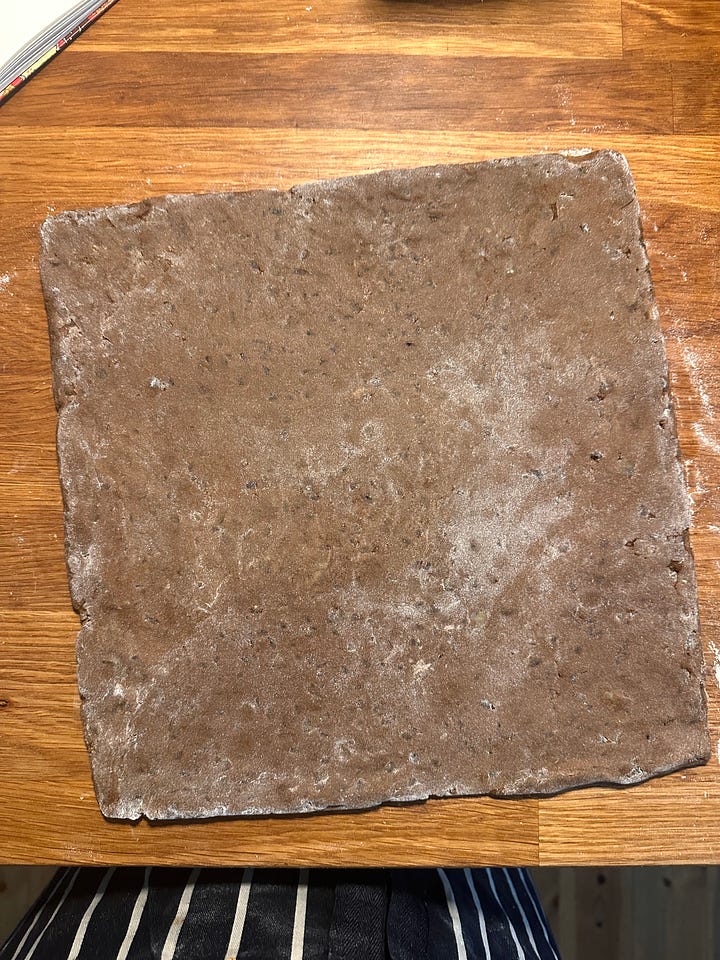
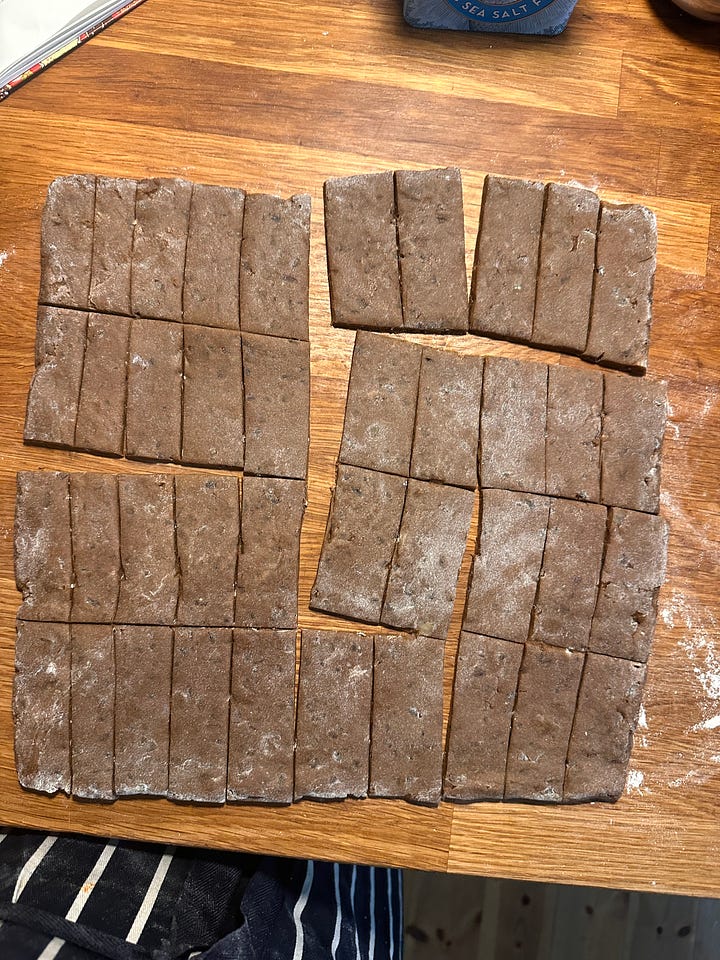
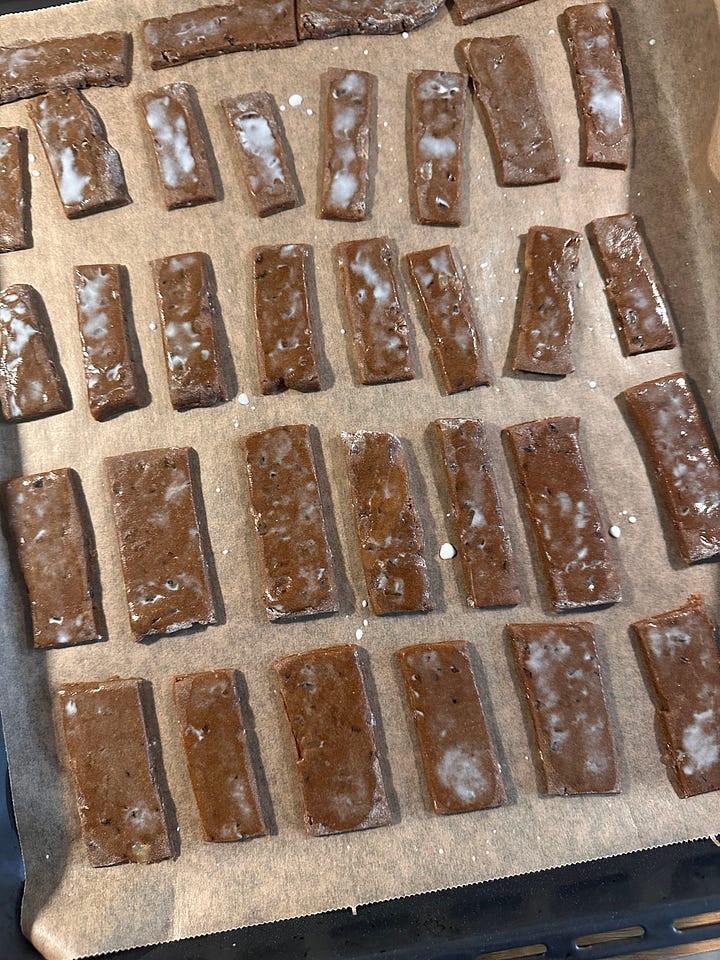
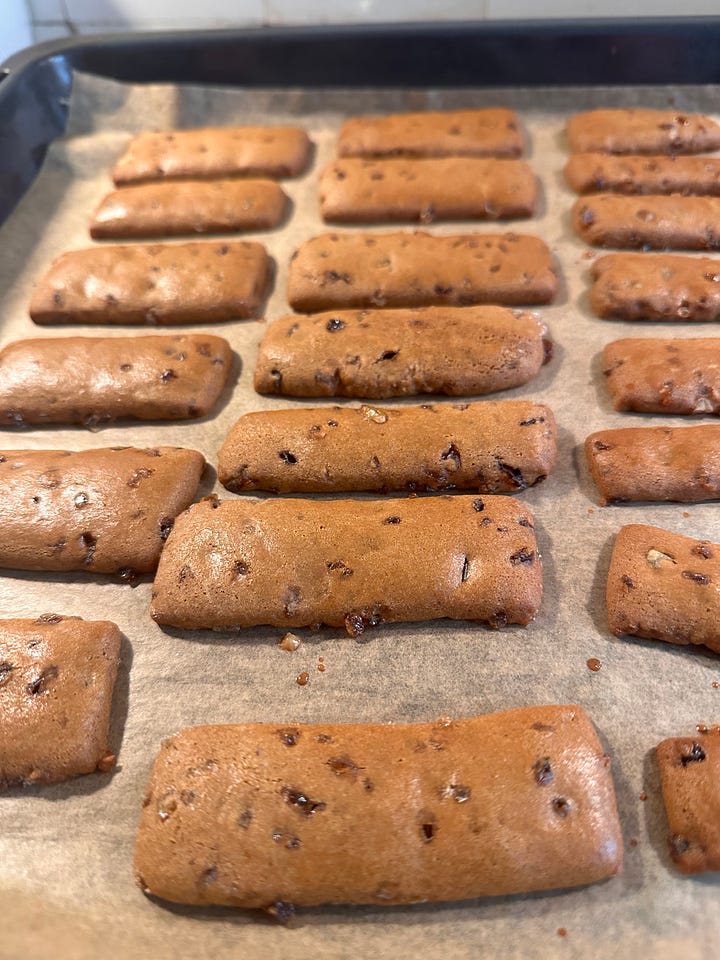
One last thing: you will need some elbow grease to mix the dough and a little more to roll it out, just so you know. The dough is very stiff. This is normal! Flour liberally, so that the dough doesn’t stick to the surface and use a sharp knife cut the tablets into the size you want. A little brush of milk and you’re off to the races.
Okay, I think I have covered everything! I am beyond excited to share this recipe with you and hope fervently that you try these wonderful cookies and that they become an integral part of your Christmas baking ritual in years to come. If you have any questions, pop them in the comments and I’ll get back to you as soon as possible.
Happy baking!
Printen
Candied Orange Gingerbread Tablets
Makes about 65 Printen or more if cut smaller
500 grams Zuckerrübensirup
100 grams granulated sugar
150 grams Grümmelkandis
600 grams all-purpose flour
80 grams candied orange peel, chopped
15 grams Lebkuchengewürz (see recipe below)
1 teaspoon ground aniseed
1/2 teaspoon salt
1/2 teaspoon potash
2-3 Tbsp whole milk, for brushing
Melted bittersweet chocolate for coating, optional
Place the syrup and sugar in a small saucepan over medium-high heat and cook, stirring, until the sugar has dissolved, 3 to 5 minutes. Set aside to cool.
In a large bowl, combine the Grümmelkandis, the flour, orange peel, spices and salt.
In a small bowl, dissolve the potash in 1 tablespoon of water and set aside.
When the molasses mixture is no longer hot, pour it in the bowl with the flour. Mix with a wooden spoon, adding the potash solution. The dough will be very stiff. Mix until all the flour has been combined. Cover and refrigerate for 2 hours.
After two hours, preheat the oven to 400°F/200°C. Scrape out half the dough, which will be quite stiff, onto a floured work surface. Flour a rolling pin and the top of the dough. Roll out the dough to a 30x30 cm square, continuously flipping the dough and flouring the surface so that it doesn’t stick. The dough should be an even 1/4-cm thick. Try to square the corners so that you have a neat-ish square of dough. Cut the dough into 1-inch thick strips lengthwise and then crosswise into 2-3 inch segments. (You can also cut the Printen smaller, like Maja does. Adjust the baking time by a few minutes.)
Line two baking sheets with parchment paper. Place the cookie tablets on the prepared sheets, leaving about 1/2 inch between them. With a pastry brush, brush them thinly with the milk, then bake for 8 to 10 minutes. The tablets should be slightly puffed and look dry and dull. Place the sheets on a rack to cool for about 15 minutes, then gently tug the tablets off the parchment paper and let cool completely.
Repeat with the remaining dough.
Once completely cooled, store the Printen in cookie tins. They will keep for at least a month. If desired, you can dip the completely cooled Printen in melted bittersweet chocolate. Place the chocolate-dipped Printen on a parchment-lined baking sheet until the chocolate has set.
Hans Hipp’s Lebkuchengewürz for Printen
Makes 140 grams
40 grams ground cinnamon
25 grams ground aniseed
25 grams ground coriander
25 grams ground allspice
25 grams ground cloves
Mix together all the spices until well-combined. Store in a glass jar with a tight lid.
If I can get my act together, I will report back from the baking trenches once I have a better sense of what my final tally will include.
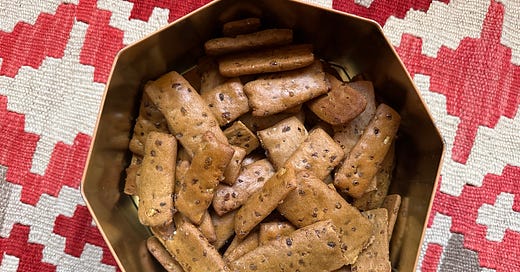



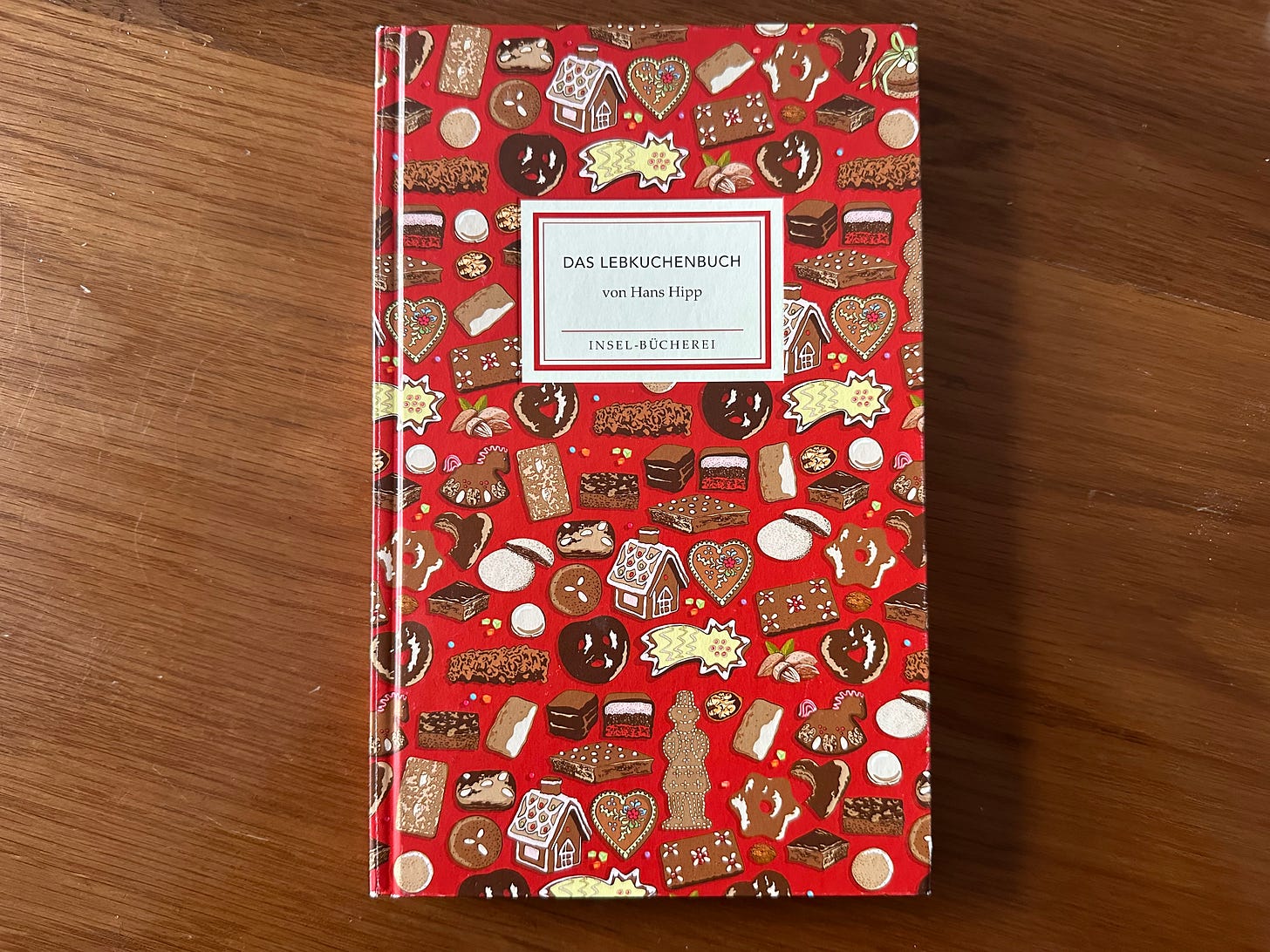
Thank you for theses generous holiday gifts💕.
I am disabled and on a limited income. I had to drop my paid Substack subscriptions even though reading about baking brings me so much joy. I can’t tell you how much it means to be able to have access to your thoughts, your stories, your recipes. I realize how hard it is for food writers to eke out a living.Your kind generosity is the best gift.
I cherish my copy of “Classic German Baking” and since my American son now lives in Bonn with his family am thrilled at the prospect of baking treats for them. I relish the notion my new grandson will someday munch on your tasty cookies.
Speaking of cookies, here I must also thank you for the Printen recipe. And I am going to take advantage of those helpful links to order the supplies. I do have Baker’s Ammonia for Springerle cookies I make but did not know about the other specialty ingredients needed.
I think I MUST see if I can find the book you mentioned on Amazon DE and have it sent to my son’s home. I can have a wonderful time with my son translating and baking with him in Bonn or virtually. Who knows? Maybe it can even become our own holiday Printen baking tradition?
I hope your holidays are filled with many blessings, with good food and great company, with love and laughter❣️🎄🎄🎄
Thank you for this post and the previous one with recipes. I appreciate your kindness in opening the paywall. My family came to US from Austria after the war
and I have enjoyed all of your posts and writing. I have your first cookbook. At my age, this recent recipe may require more work than I feel like expending but what fun to see the photos and taste the cookies in my mind! I am grateful for your work and all that goes into your Letter from Berlin. All the best to you and yours this Christmas season. Irene